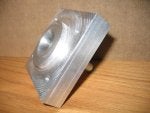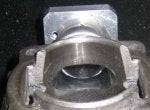I'm into building 2 stroke race engines, they don't need to run long, but they need to run fast.
In some cases it would be an advantage to be able to build up a couple mm on the center of the piston crown to reduce head volume and increase compression. I figure this is fairly doable just by adding a pad of 5356 filler on the center of the piston crown and then turning it down on a lathe. Is 5356 the best option for filler though? Pistons have a lot of silicon to control thermal expansion and make them harder. They need to stand up to temperatures about 280 C or 550 F, but are not subject to extreme loads.
The second more difficult moddification I had in mind was building up the sides of a piston skirt, I have herd of this being done before, Some work to remachiene the pistons after, but I think I can manage that part ok. In this case the loading is a lot higher, but temperatures less than 100c or 210F.
Any thoughts on filler or heat treatment. How is welding going to effect grain structure in the high silicon aluminium alloy?
Thanks
First pic shows a slight pop up on the piston, I would like to build this up higher, second pic shows piston skirts, the piston on the right has a wider extended skirt, this is what I would like to add to the piston on the left.
I know the machiening is very close tolerence <0.001, I'm ok with that part. This is not production stuff, just one off experimental projects.
In some cases it would be an advantage to be able to build up a couple mm on the center of the piston crown to reduce head volume and increase compression. I figure this is fairly doable just by adding a pad of 5356 filler on the center of the piston crown and then turning it down on a lathe. Is 5356 the best option for filler though? Pistons have a lot of silicon to control thermal expansion and make them harder. They need to stand up to temperatures about 280 C or 550 F, but are not subject to extreme loads.
The second more difficult moddification I had in mind was building up the sides of a piston skirt, I have herd of this being done before, Some work to remachiene the pistons after, but I think I can manage that part ok. In this case the loading is a lot higher, but temperatures less than 100c or 210F.
Any thoughts on filler or heat treatment. How is welding going to effect grain structure in the high silicon aluminium alloy?
Thanks
First pic shows a slight pop up on the piston, I would like to build this up higher, second pic shows piston skirts, the piston on the right has a wider extended skirt, this is what I would like to add to the piston on the left.
I know the machiening is very close tolerence <0.001, I'm ok with that part. This is not production stuff, just one off experimental projects.




![piston%205[1].jpg](/d1/attachments/23/23563-b1f9946a27b10f9d52a449a301f17f17.jpg)









![NOS%201[1].jpg](/d1/attachments/23/23598-ec0f60299b9a3df431db2fbc120ea77c.jpg)




